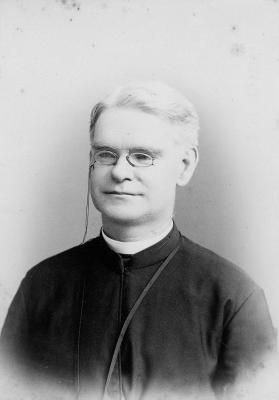President: 1882-1888
Fr. James Doonan, S.J., served as Georgetown's 30th president from 1882-1888. Fr. Doonan inherited a financially struggling university and made impressive strides in reducing Georgetown's debt.
Early academic career
Fr. Doonan first arrived at Georgetown in 1853 as a young student on the “small boys’ side” where he distinguished himself in his studies and became captain of the student cadet regiment. In 1857, he entered the Jesuit novitiate in Frederick. At the start of the Civil War, Fr. Doonan was teaching at Loyola University in Baltimore, where he was soon drafted into the Union Army and forced to patrol the streets of Baltimore. Fr. Doonan then taught at Boston College before returning to Georgetown in 1867 to study Philosophy. In 1869, he departed for Woodstock where he finished his studies in Philosophy and Theology. In 1876, Fr. Doonan returned to Georgetown where he became a Professor of Poetry. When Fr. Patrick Healy, plagued by worsening health, resigned in 1882, Fr. Doonan was appointed his successor and became Georgetown's thirtieth President.1
Debt challenges
Fr. Doonan inherited an enrollment of barely one hundred students, Fr. Healy’s unfinished building, and a debt of nearly $300,000. Around this time, one of Georgetown’s night watchmen approached Fr. Doonan and asked for his help in securing a spot at the poor-house. Fr. Doonan responded, "Well, Davy, if you can find a poorer house than this anywhere, I advise you to go there and I will aid you in getting into it." Davy the night watchman remained at Georgetown until his death two years later.2 Much of Fr. Doonan’s efforts were directed at paying down Georgetown’s debt. He began by selling two large tracts of University-owned land, a villa in Tenleytown and a farm on Hickory Hill near present-day Glover Park.3
Fundraising and centenary
With Georgetown’s centenary fast approaching, Fr. Doonan used the occasion to bolster fundraising and donations among Georgetown’s alumni. At the 1888 Commencement, Fr. Doonan remarked that if Georgetown, in its “dowerless existence of a hundred years,” had “achieved what we congratulate ourselves upon today, this measure of success gives every encouragement to the hope that in the second century of her work the noble ambition of her founders may draw nigh to realization.”4
Fr. Doonan’s other centenary-minded efforts included the naming of Gaston Hall after Georgetown’s first student, “not a college in our land has on the first page of its register a name more to be honored than his who heads the roll of Georgetown’s students,”5 and the purchase of two cannons that now stand outside the eastern entrance of Healy Hall. These cannons guarded Fort Point and St. Mary’s City during Lord Baltimore’s 1634 expedition to St. Mary’s County. Originally located on the banks of the St. Mary’s River, they had fallen into the river as the banks eroded. In 1824, they were removed from the muddy water and transported to St. Inigoes for restoration. In 1885, Fr. Doonan paid $50 for them, and they were mounted on blocks of Potomac gneiss outside Healy Hall in 1888.6
Departure and legacy
Although Fr. Doonan’s term ended in August of 1888, before the 1889 centenary celebration, his fundraising efforts were remarkably successful. Fr. Richards, his successor, inherited a debt that had been reduced from $300,000 to almost $50,000.
Upon hearing the news of Fr. Doonan's departure, students for The College Journal wrote: “When Fr. Doonan assumed the Presidency of the College, Georgetown was passing through one of the darkest hours of its existence. By skillful management, by persistent and unbending devotion to duty, he brought the College back to its former career of splendid success. Fr. Doonan was one of a thousand. Profoundly versed in the learning that the world’s “ master-spirits have embalmed in books,” full of the deeper and subtler wisdom that is born of the ruler’s contact with men, gracious yet firm-handed, gentle and strong in one, Fr. Doonan came as near realizing our ideal of a Georgetown College President as any man we have ever known.”7
- 1“Father James A. Doonan” Woodstock Letters, Vol. XL, 1911, pp.373-76.
- 2Id. at p.375.
- 3Andrew Dwulet. “A Campaign Unfinished.” The Hoya. 18 Sept. 2009.
- 4Gilmary Shea, John. “Memorial of the First Century of Georgetown College, D.C.” 1891, p.300.
- 5Id.
- 6"Fact or Fiction? Mythbusting Hoya History with the University Archives." Georgetown University Library. 23 Aug. 2016.
- 7“Topics of the Hour.” Georgetown College Journal, Vol. 17, No. 1. Oct. 1888, p.2.


